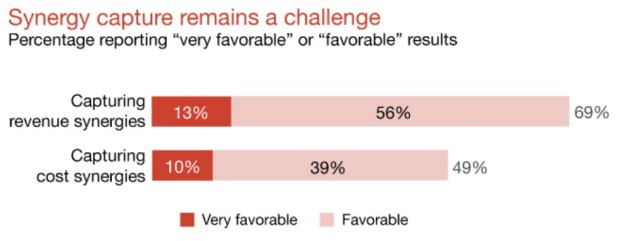M&A: Estimating Procurement Cost Synergies
A reliable estimate of zero-disruption Procurement cost synergies can be performed quickly and easily as part of the pre-merger “clean room” exercise. Using Spendata, the only data necessary are last year’s spend by vendor and a list of contracts. Both of these should be readily available as part of a normal clean room data draw.
Challenges
It’s notoriously tricky to accurately calculate the impact of cost synergy on merger premiums. This chart from PwC’s 2020 M&A Integration Survey shows there’s a lot of room for improvement:

From smartsheet.com: “.. buyers are often overly optimistic in forecasting cost savings.” And, “...extensive data cleaning may be necessary to combine systems.”
Post-merger, procurement cost synergies can be targeted and estimated with a properly-structured combined-company spend cube. However, building such a cube pre-merger is generally not possible or practical. Even if such a cube were available, and potential savings initiatives were identified, it would be difficult to determine pre-merger whether the companies would be able to switch vendors or take other disruptive steps necessary to realize the savings.
A Believable Procurement Cost Synergy Estimate
What’s needed is a procurement cost synergy estimate that is both believable and achievable, that does not cause or assume disruption to either company, and that identifies savings that can be realized in the short term (say, in the first 90 days after the merger).
The key idea, therefore, is to avoid savings initiatives that cause operational difficulties. To accomplish this, we focus on vendors. If both companies are using the same vendor, then modifying the relationship with that vendor, such as negotiating a better discount because of higher volume, causes no disruption to operations. Similarly, if one company has a contract with a vendor and the other does not have a contract, moving the latter’s spend under that existing contract causes no disruption either.
Savings accruing from these actions represent an achievable lower bound on procurement cost synergies that can be factored confidently into the merger premium.
Connecting the Dots
The estimation process itself can be completed in a few hours. Briefly, last year’s spend by vendor and contracts by vendor are loaded into Spendata for both companies, and Spendata’s highly-tuned automated familying functionality is used to merge the vendors. This is followed by a quick review of the model, making adjustments to it using Spendata’s drag-and-drop familying and mapping functions.
Out of a pre-built Spendata workspace then comes an estimate of realizable near-term savings. The parameters used for the estimate can be adjusted in detail as necessary — the defaults are (1) experiential estimates of volume savings discounts as a function of the basis and the delta spend, and (2) sourcing-based estimates of savings for on-contract versus off-contract buys as a function of volume.
Try doing all of that in Excel! (See you in a few weeks.)
As a side-effect of the vendor merging process, some additional insights can surface. For example, the percentage of overlapping vendors could be viewed as a proxy for how differently the companies think, and therefore for how straightforward the merger process is likely to be. Also, if one or the other company finds it difficult to produce spend by vendor for the last year, or to produce a list of contracts, then it's likely safe to take a more aggressive guess at overall procurement synergy savings.

